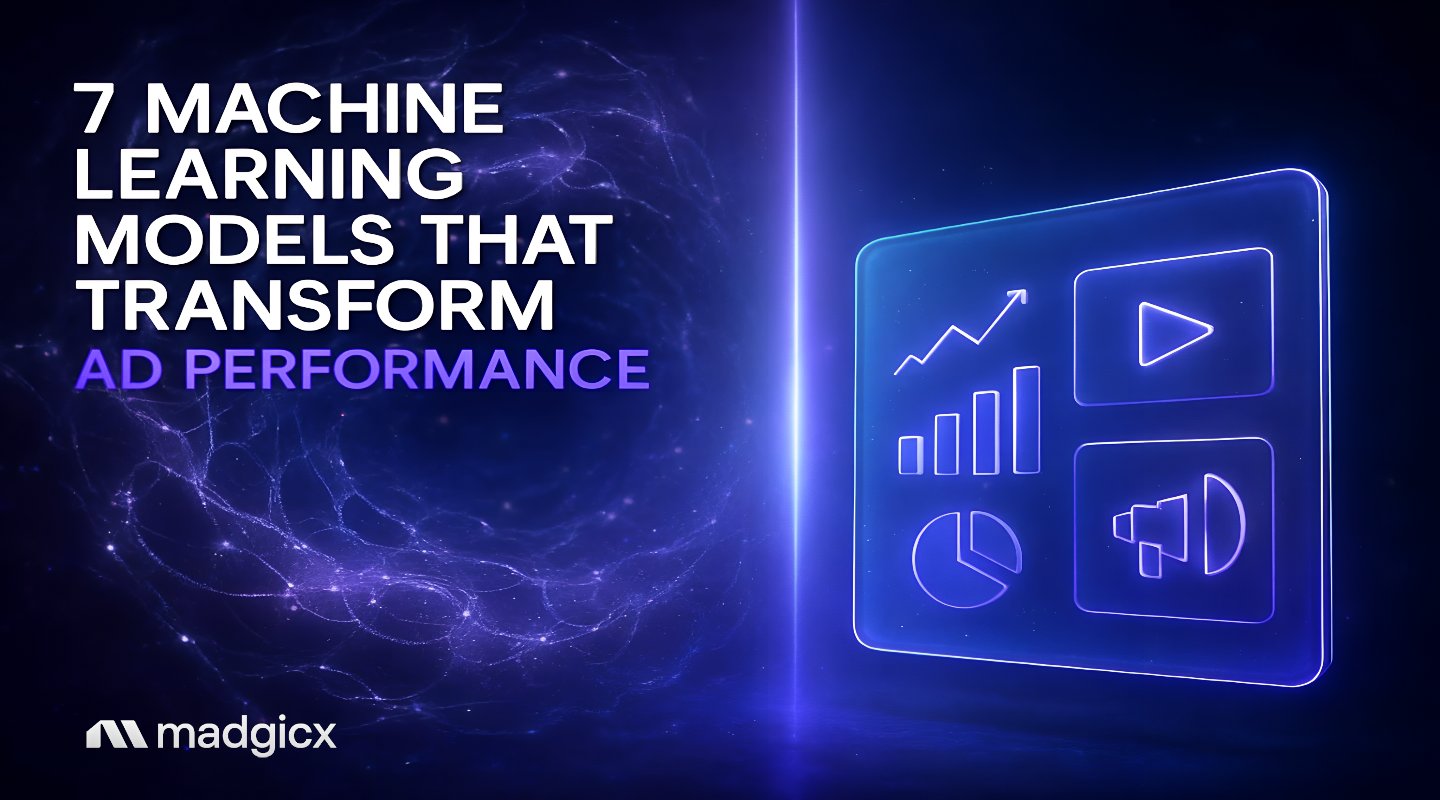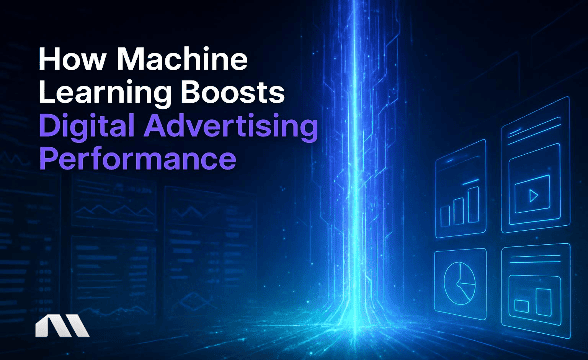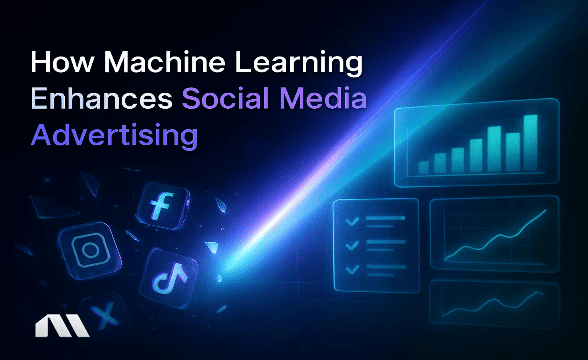Discover 7 proven machine learning models for advertising optimization. From Random Forest to XGBoost, learn which algorithms deliver real ROI for campaigns.
Wondering which machine learning model could help improve your advertising performance? You're not alone.
While everyone's talking about AI revolutionizing advertising, most performance marketers are stuck in analysis paralysis. They know ML works but have no clue which models to implement first.
Here's something that might surprise you: Random Forest achieved 92% accuracy and an F1-score of 89% in predicting advertising click-through rates, outperforming other ensemble methods in head-to-head testing. But here's the kicker – Random Forest isn't even the highest-performing model for every advertising use case.
The challenge isn't whether machine learning models using advertising data work (they do). The challenge is cutting through the technical jargon to understand which specific models deliver results for CTR prediction, audience targeting, and campaign optimization.
You need a practical framework that tells you exactly which algorithm to implement based on your data, budget, and timeline. That's exactly what you'll get in this guide: 7 proven ML models with specific use cases, realistic implementation requirements, and expected performance benchmarks. No PhD required.
What You'll Learn
By the end of this guide, you'll know exactly which ML models work best for CTR prediction, audience targeting, and budget optimization. We'll cover specific data requirements and implementation timelines for each model type, plus how to choose between Random Forest, XGBoost, and Neural Networks for your specific use case.
As a bonus, you'll get real-world performance benchmarks and ROI expectations from leading advertising platforms. The kind of data that usually stays locked behind enterprise NDAs.
Understanding Machine Learning Models Using Advertising Data
Let's be honest – machine learning can feel like a black box where data goes in and magic comes out. But understanding the basics isn't rocket science, especially when you focus on what actually matters for advertising performance.
Machine learning models using advertising data are algorithms that learn patterns from your campaign metrics to make predictions about future performance. They fall into two main categories: supervised learning (where you train the model with known outcomes like "this ad converted") and unsupervised learning (where the model finds hidden patterns without predetermined outcomes).
For advertising optimization, you'll primarily work with supervised learning models that handle two types of predictions:
Classification models predict categories (will this user click? yes/no). Regression models predict numerical values (what will this campaign's CTR be? 2.3%). Most advertising applications use classification since we're usually predicting binary outcomes like clicks, conversions, or engagement.
Ensemble methods combine multiple algorithms to improve accuracy and reduce the risk of any single model making poor predictions. Think of it like getting a second opinion from multiple doctors – the combined diagnosis is usually more reliable than any individual assessment.
Here's why this matters for your campaigns: According to recent industry research, 41% of decision-makers plan to use machine learning for campaign optimization. The question isn't whether you'll use ML – it's which models you'll implement first and how quickly you can get them working for your performance goals.
Pro Tip: Start by identifying your biggest performance bottleneck. Is it audience targeting accuracy? Creative optimization? Bid management? Your primary challenge should drive your first ML model choice.
Random Forest: The Reliable Performer for Advertising Data
Random Forest is like having a committee of experts vote on every advertising decision. Except these experts are decision trees, and they're incredibly good at predicting click-through rates and conversion probability from your advertising data.
How It Works
Random Forest combines multiple decision trees, each trained on different subsets of your advertising data. When making a prediction, all trees "vote" and the majority decision wins. This approach reduces overfitting (when a model memorizes your training data but fails on new data) and improves accuracy across diverse advertising scenarios.
Best Use Cases for Advertising Data
- CTR prediction for new ad creative
- Conversion probability scoring for audience segments
- Quality score optimization for search campaigns
- Cross-platform performance forecasting
Data Requirements
You'll need a minimum of 10,000 data points for reliable results, though Random Forest performs well with smaller datasets compared to other advanced models. It handles mixed data types beautifully – combining numerical metrics (CTR, CPC) with categorical data (device type, geographic location) without extensive preprocessing.
Implementation Timeline
Expect 2-4 weeks for basic setup and initial training, with 6-8 weeks needed for full optimization and performance validation. The relatively quick implementation makes Random Forest an excellent starting point for teams new to ML optimization.
Real-World Performance
That 92% accuracy rate we mentioned earlier isn't just impressive – it's practical. Random Forest excels at handling advertising data's inherent complexity, from seasonal variations to audience behavior shifts.
The model's ability to identify feature importance also helps you understand which factors most influence your campaign performance.
Why It Works for Advertising
Random Forest naturally handles the noise and variability in advertising data. Unlike single decision trees that might overreact to outliers (like that one viral post that skewed your engagement metrics), Random Forest's ensemble approach provides stable, reliable predictions even when individual campaigns behave unexpectedly.
Madgicx's AI Marketer leverages Random Forest principles in its audience creation and Meta ad optimization algorithms, automatically identifying high-value audience segments without requiring manual feature engineering or model tuning.
XGBoost: The Performance Champion
If Random Forest is a reliable committee, XGBoost is an advanced algorithm that iteratively improves performance by learning from previous model errors. This gradient boosting algorithm has become the gold standard for competitive machine learning – and for good reason.
How It Works
XGBoost builds models sequentially, with each new model specifically designed to correct the errors made by previous models. This iterative improvement process, combined with advanced regularization techniques, produces exceptionally accurate predictions while avoiding overfitting.
Best Use Cases for Advertising Data
- Real-time bid optimization
- Dynamic budget allocation across campaigns
- Performance forecasting for quarterly planning
- Cross-channel attribution modeling
- Audience lookalike scoring
Data Requirements
XGBoost shines with larger datasets – ideally 50,000+ data points for optimal performance. The model also benefits significantly from feature engineering, so plan time for creating meaningful variables from your raw advertising data (like time-based features, interaction terms, and aggregated metrics).
Implementation Timeline
Budget 4-6 weeks for full implementation, including the crucial feature preparation phase. While XGBoost can deliver quick wins, maximizing its potential requires careful feature selection and hyperparameter tuning.
Real-World Performance
XGBoost achieved 94.10% accuracy in advertising click prediction tasks, outperforming Random Forest and other ensemble methods. This performance advantage becomes even more pronounced in competitive advertising environments where small accuracy improvements translate to significant ROI gains.
Why It Dominates Competitive Scenarios
XGBoost's sequential learning approach makes it exceptionally good at finding subtle patterns that other models miss. In advertising, this translates to better identification of high-value micro-segments, more accurate bid adjustments, and superior performance in auction-based environments.
Leading advertising platforms rely heavily on XGBoost for real-time bidding decisions. The algorithm's speed and accuracy make it ideal for the split-second decisions required in programmatic advertising, where milliseconds can determine whether you win or lose an auction.
Pro Tip: XGBoost's feature importance scores provide invaluable insights into what drives your advertising performance. Use these insights to inform creative strategy, audience targeting, and budget allocation decisions beyond just automated optimization.
The complexity is worth it when you need maximum performance, but consider starting with Random Forest if you're new to machine learning for advertising optimization and building up to XGBoost as your data and expertise grow.
Neural Networks: The Pattern Recognition Expert
Neural networks are advanced machine learning tools for advertising that are capable of identifying complex patterns in data that simpler algorithms may miss. But like any powerful tool, they require skill and resources to wield effectively.
How It Works
Neural networks mimic the structure of the human brain, with interconnected nodes (neurons) organized into layers. Each layer processes information and passes it to the next, allowing the network to learn increasingly complex patterns.
Deep learning networks with multiple hidden layers can identify subtle relationships in advertising data that traditional algorithms miss entirely.
Best Use Cases for Advertising Data
- Creative optimization and performance prediction
- Advanced lookalike audience modeling
- Cross-platform attribution analysis
- Dynamic creative optimization (DCO)
- Video engagement prediction
- Complex customer journey mapping
Data Requirements
Neural networks are data-hungry beasts. You'll need 100,000+ data points for meaningful results, plus significant computational resources for training and inference. The good news? Once trained, they can process new data incredibly quickly.
Implementation Timeline
Plan for 8-12 weeks including model architecture design, training, and validation. This timeline assumes you have clean, well-structured data – add several weeks if you need extensive data preprocessing.
Real-World Performance
Google reported that AI-powered video campaigns using neural networks delivered 17% higher ROAS compared to traditional optimization methods. This performance boost comes from neural networks' ability to understand complex creative elements, audience interactions, and temporal patterns that simpler models can't capture.
Why They Excel at Creative Optimization
Neural networks can analyze visual elements, text sentiment, and audience response patterns simultaneously. This makes them exceptionally powerful for predicting which creative variations will resonate with specific audience segments – something that's nearly impossible with traditional rule-based systems.
The Computational Reality
Neural networks require serious computing power. Unless you're running enterprise-scale campaigns with massive budgets, the cost-benefit analysis often favors simpler models for most advertising use cases.
However, the landscape is changing rapidly as cloud computing costs decrease and AI advertising platforms make neural network capabilities accessible without requiring in-house expertise.
When the Complexity Is Worth It
Consider neural networks when you have large, complex datasets with multiple interaction effects, when creative optimization is a primary concern, or when you're working across multiple platforms with different audience behaviors. The investment pays off when pattern complexity exceeds what traditional models can handle effectively.
For most performance marketers, neural networks work best as part of a broader ML strategy rather than a starting point. Build your foundation with Random Forest or XGBoost, then graduate to neural networks when your data and use cases justify the additional complexity.
Logistic Regression: The Interpretable Baseline
Don't let the fancy name fool you – logistic regression is the Swiss Army knife of machine learning models using advertising data. Simple, reliable, and refreshingly transparent about how it makes decisions.
How It Works
Logistic regression is a statistical model that calculates the probability of a binary outcome (click/no click, convert/no convert) based on input features. Unlike black-box algorithms, logistic regression provides clear coefficients showing exactly how each factor influences the prediction.
Best Use Cases for Advertising Data
- A/B testing analysis and statistical significance
- Simple conversion prediction models
- Regulatory compliance scenarios requiring explainable AI
- Baseline performance benchmarking
- Client reporting where transparency matters
- Quick proof-of-concept implementations
Data Requirements
Logistic regression works with surprisingly small datasets – as few as 1,000 data points can produce meaningful results. This makes it perfect for testing new markets, products, or audience segments where you don't have extensive historical data.
Implementation Timeline
You can have a working logistic regression model in 1-2 weeks, including data preparation and validation. This speed makes it ideal for rapid testing and quick wins while you develop more sophisticated models.
Real-World Performance
Logistic regression achieved 93.23% accuracy in advertising prediction tasks, proving that simplicity doesn't mean sacrificing performance. While it may not match XGBoost's peak accuracy, the difference is often negligible for many practical applications.
Why Simplicity Sometimes Wins
In advertising, explainability often trumps marginal accuracy gains. When you need to explain to stakeholders why the algorithm made specific decisions, or when working in regulated industries, logistic regression's transparency becomes invaluable.
Perfect for Agency Work
If you're managing client campaigns, logistic regression's interpretability makes client presentations much easier. You can show exactly which factors drive performance and how changes in targeting or creative elements will impact results.
The Baseline Advantage
Smart performance marketers use logistic regression as their baseline model. It's quick to implement, easy to understand, and provides a performance benchmark for evaluating more complex algorithms. If XGBoost only improves accuracy by 2% over logistic regression, you might decide the additional complexity isn't worth it.
Pro Tip: Start every ML project with logistic regression. It forces you to clean your data properly, understand your features, and establish realistic performance expectations. Plus, you'll often discover that the simple model performs better than expected, saving you weeks of complex model development.
For teams new to machine learning algorithms in advertising, logistic regression provides an excellent learning foundation without overwhelming technical complexity.
Ensemble Methods: Combining the Best Models
Why choose one machine learning model when you can harness the power of several? Ensemble methods are like assembling an all-star team where each player brings unique strengths to win the championship.
How It Works
Ensemble methods combine predictions from multiple models to produce a final result that's typically more accurate and robust than any individual model. Common approaches include voting (majority rules), averaging (mean of predictions), and stacking (using another model to combine base model predictions).
Best Use Cases for Advertising Data
- Complex optimization scenarios with multiple objectives
- High-stakes campaigns where accuracy is paramount
- Reducing model risk and improving reliability
- Situations requiring both interpretability and performance
- Cross-platform campaign optimization
Data Requirements
Requirements vary based on component models, but generally you'll need sufficient data to train multiple algorithms effectively. Plan for datasets of 25,000+ data points to get meaningful ensemble benefits.
Implementation Timeline
Budget 6-10 weeks for ensemble implementation, including time to develop, train, and validate multiple base models. The additional complexity is offset by significantly improved reliability and performance.
Real-World Application
Leading advertising platforms use ensemble approaches extensively. Madgicx's AI optimization combines multiple machine learning approaches to deliver comprehensive Meta campaign optimization that no single model could achieve alone.
The Risk Reduction Advantage
Individual models can fail spectacularly when they encounter data patterns they weren't trained on. Ensemble methods provide insurance against these failures – if one model makes a poor prediction, others can compensate.
Types of Ensemble Approaches
- Bagging: Train multiple models on different data subsets (Random Forest is actually a bagging ensemble)
- Boosting: Sequential models that learn from previous mistakes (XGBoost uses this approach)
- Stacking: Use a meta-model to learn how to best combine base model predictions
- Voting: Simple majority vote or weighted average of model predictions
When to Use Ensemble Methods
Consider ensembles when single models plateau in performance, when you need maximum reliability for high-value campaigns, or when different models excel at different aspects of your optimization challenge.
Pro Tip: Start with a simple ensemble of your two best-performing individual models. If Random Forest and XGBoost both perform well on your data, a weighted average of their predictions often outperforms either model alone.
The beauty of ensemble methods lies in their ability to capture the best aspects of different algorithmic approaches while minimizing individual model weaknesses – making them ideal for the complex, multi-faceted challenges of modern advertising optimization.
Model Selection Framework: Choosing the Right Approach
Choosing the right machine learning model doesn't have to feel like solving a Rubik's cube blindfolded. Here's your practical decision framework based on budget, complexity, and performance requirements.
Small Budget/Simple Needs → Logistic Regression
- Budget: Under $10K monthly ad spend
- Timeline: Need results in 1-2 weeks
- Data: Less than 10,000 data points
- Priority: Transparency and explainability
- Best for: A/B testing, simple conversion prediction, client reporting
Medium Complexity/Proven ROI → Random Forest
- Budget: $10K-$100K monthly ad spend
- Timeline: Can invest 4-6 weeks for implementation
- Data: 10,000-50,000 data points available
- Priority: Reliable performance with manageable complexity
- Best for: CTR prediction, audience scoring, multi-platform optimization
High Performance Requirements → XGBoost
- Budget: $100K+ monthly ad spend
- Timeline: 6-8 weeks acceptable for competitive advantage
- Data: 50,000+ data points with good feature engineering potential
- Priority: Maximum accuracy and performance
- Best for: Real-time bidding, dynamic budget allocation, competitive markets
Complex Pattern Recognition → Neural Networks
- Budget: $500K+ monthly ad spend or enterprise-level campaigns
- Timeline: 8-12 weeks for full implementation
- Data: 100,000+ data points with rich feature sets
- Priority: Advanced creative optimization and cross-platform attribution
- Best for: Creative optimization, complex customer journeys, video campaigns
Maximum Reliability → Ensemble Methods
- Budget: Significant investment in advertising technology
- Timeline: 10+ weeks for comprehensive implementation
- Data: Large, diverse datasets across multiple touchpoints
- Priority: Risk reduction and consistent performance
- Best for: Multi-objective optimization, high-stakes campaigns, platform-agnostic strategies
Implementation Readiness Checklist
✅ Clean, structured data with consistent formatting
✅ Clear performance metrics and success criteria defined
✅ Sufficient historical data for chosen model type
✅ Technical resources for implementation and maintenance
✅ Realistic timeline expectations based on model complexity
✅ Budget for both implementation and ongoing optimization
Data Quality Requirements
- Completeness: Missing data should be less than 5% of total dataset
- Consistency: Standardized formats across all data sources
- Relevance: Features directly related to advertising performance
- Recency: Data should represent current market conditions
- Volume: Sufficient examples for each outcome category
Realistic ROI Timelines
- Logistic Regression: 2-4 weeks to measurable improvement
- Random Forest: 4-8 weeks for optimization benefits
- XGBoost: 6-12 weeks for full performance gains
- Neural Networks: 12-16 weeks for complex pattern recognition benefits
- Ensemble Methods: 8-16 weeks depending on component complexity
Remember: According to industry research, machine learning-based targeting boosted click-through rates by 66.8% compared to traditional targeting systems, and marketing teams implementing AI solutions see an average ROI of 300%. But this return comes from choosing the right model for your specific situation, not necessarily the most advanced algorithm available.
Pro Tip: Start with your current capabilities and scale complexity as you prove value and build expertise. The best machine learning model is the one you can implement successfully and maintain consistently.
Frequently Asked Questions
How much data do I need to start using ML models effectively?
The data requirements vary significantly by model type. Logistic regression can work with as few as 1,000 data points, making it perfect for testing new markets or products. Random Forest needs around 10,000 data points for reliable results, while XGBoost performs best with 50,000+ data points.
Neural networks require 100,000+ data points to avoid overfitting. However, data quality matters more than quantity – 10,000 clean, relevant data points will outperform 100,000 messy, inconsistent records every time.
Which model should I implement first as a performance marketer?
Start with logistic regression to establish your baseline and clean your data processes. Once you have that foundation, Random Forest is typically the best next step for most performance marketers.
It provides significant accuracy improvements over logistic regression while remaining interpretable and manageable. Only move to XGBoost or neural networks after you've maximized the value from simpler models and have the data volume to support more complex algorithms.
How long before I see measurable improvements from ML optimization?
Timeline depends on your chosen model and implementation approach. Logistic regression can show improvements in 2-4 weeks, Random Forest typically delivers results in 4-8 weeks, and XGBoost may take 6-12 weeks for full optimization benefits.
Neural networks often require 12-16 weeks before you see the complex pattern recognition advantages. However, you should see directional improvements much earlier – the timeline refers to when you'll have statistically significant, sustainable performance gains.
Can I use multiple models simultaneously without conflicts?
Absolutely, and it's often recommended. Many successful advertising operations use different models for different purposes – logistic regression for quick A/B test analysis, Random Forest for audience scoring, and XGBoost for bid optimization.
The key is ensuring each model has a clear, distinct purpose and that you're not creating conflicting optimization signals. Ensemble methods formalize this approach by systematically combining multiple models for better overall performance.
What happens when ML models make incorrect predictions?
Model errors are inevitable and manageable with proper safeguards. Implement performance monitoring to catch accuracy degradation early, set up automated alerts when predictions deviate significantly from actual results, and maintain fallback rules for extreme scenarios.
Most importantly, never let any model operate completely autonomously – always maintain human oversight and the ability to override algorithmic decisions. Regular model retraining and validation help minimize prediction errors over time.
Your ML Implementation Roadmap
Machine learning models using advertising data continue to accelerate adoption across the industry. But success doesn't require implementing every advanced algorithm simultaneously.
Smart performance marketers build their ML capabilities systematically, starting with proven, manageable models and scaling complexity as they demonstrate value.
Your Quick Reference Guide
- Logistic Regression: Start here for transparency and quick wins
- Random Forest: The reliable workhorse for most advertising use cases
- XGBoost: When you need maximum performance and have the data to support it
- Neural Networks: For complex creative optimization and pattern recognition
- Ensemble Methods: Combine approaches for maximum reliability and performance
The 2025 Reality
The trend is clearly toward automated ML platforms that make advanced algorithms accessible without requiring PhD-level expertise. According to recent industry analysis, 41% of decision-makers plan to implement machine learning optimization within the next two years, but the winners will be those who start with solid foundations rather than jumping to the most complex solutions.
Your Next Steps
- Audit your current data quality and volume to determine which models are realistic starting points
- Choose one model based on your budget, timeline, and performance requirements
- Implement baseline measurement to track improvement accurately
- Start small with a single campaign or audience segment to prove value
- Scale systematically as you build confidence and expertise
The most successful performance marketers don't try to become machine learning experts overnight. They partner with platforms that provide enterprise-level ML optimization without the complexity, allowing them to focus on strategy and results rather than algorithm development.
Madgicx's AI Marketer represents this accessible approach to advanced machine learning – combining Random Forest reliability, XGBoost performance, and ensemble method sophistication in a platform designed for performance marketers who want results, not research projects. While building custom ML models takes months, you can start benefiting from advanced algorithmic optimization immediately.
The question isn't whether machine learning will transform your advertising performance – it's whether you'll lead the transformation or follow it.
While building custom ML models takes months of development and testing, Madgicx's AI Marketer uses advanced ensemble methods to optimize your Meta campaigns automatically. Access Random Forest, XGBoost, and Neural Networks capabilities for your advertising optimization with reduced complexity and technical overhead.
Digital copywriter with a passion for sculpting words that resonate in a digital age.







.avif)







